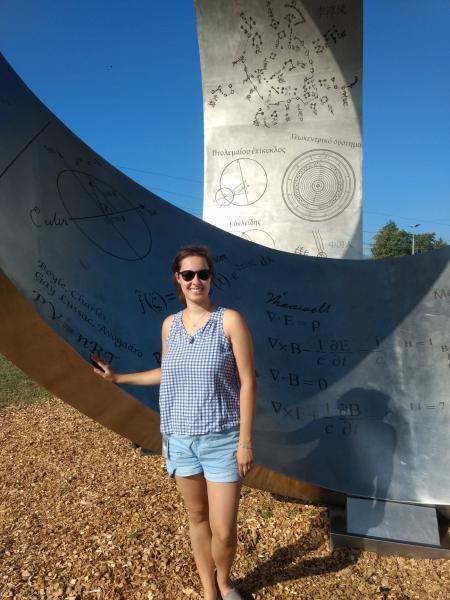Ever since I started to study physics in high school, I dreamed about visiting CERN. I just didn’t imagine that soon I would actually work there. I am from Brazil and really great inspiration to me was to meet Prof. Sérgio Novaes and his group in São Paulo, who are part of the CMS collaboration. I could see their eyes shining as they were explaining how the detector works, what they were searching for, and all the technology involved in it. I got so excited that for a moment I wanted to be part of that too. Just one year later I met them all at CERN!
CMS by itself produces 600 megabytes of collision data per second. The simulation data which is equally important is of the same order of magnitude. This scenario brings a mutual relationship between two different fields: data science and particle physics. Particle physics can take advantage of machine learning algorithms to filter, process, and analyze this huge amount of data. On the other hand, machine learning, which generally suffers from the lack of labeled datasets of large scale for supervised learning, has a chance to extend its domain and develop new paradigms based on this new field.
In my latest project, I have been working on applying Generative Adversarial Networks to calorimeter simulation. What does that mean? Let’s start with the calorimeter simulation part. We “see” the particles in the detector according to the trace that they leave in it. The electromagnetic calorimeter and the hadronic calorimeter are shown in the image below. Particles deposit their energy in a process known as showering. They can shower into secondary particles, which in turn can also shower into the calorimeter. The shape and density of such shower is characteristic of each particle type. These showers develop longitudinally, and every cell of the calorimeter registers the energy deposition. Ordinarily, physicists execute Monte Carlo simulations to generate this data. However, this process is computationally expensive and will not suffice to supply all the demand for big and accurate simulation samples. So in my project we propose to apply Generative Adversarial Networks (GANs) to tackle this problem.

In a GAN environment, there are two neural networks: a generator, which generates samples from noise fed to a latent space, and a discriminator, which receives both real and generated samples, and tries to distinguish which ones are real or generated. As training goes on, the two networks compete against each other, so that the discriminator learns to discriminate the samples, and as result the generator has to produce samples of better quality -- that is, more similar to the real samples. Although this approach suffers from unstable training, the results achieved are astonishing. It is an impactful to application to our calorimeter simulation problem because not only the generated samples are accurate, but they also come with a computational speedup in the generation process of three orders of magnitude, and a reasonably short training time.
When I was at CERN for the first time, I was working in the Caltech group at CMS under the supervision of Prof. Maria Spiropulu, Dr. Jean-Roch Vlimant, and Dr. Maurizio Pierini. At first, I could not figure out the data I had and could not understand how to feed it into a deep neural network. But I was in such a supportive environment that I quickly filled in the gaps in my understanding. There were also different seminars and the CMS Machine Learning Workshop, they also contributed to my understanding of applying machine learning to particle physics. It was a very fruitful time for me. That summer played an important role in my career, I gained very valuable experience, which allowed me to do various kinds of research work and I am very grateful for that.
I came back one year later as a CERN Openlab summer student to work once again at CMS on fast calorimeter simulation with deep learning. CERN Openlab (https://openlab.cern/) is a public-private partnership between CERN and leading ICT companies. During this stay I was treated as equal with other scientists and was given independence in my project. I am very impressed with the knowledge that physicists have, and especially my supervisors. They are full of new revolutionary ideas, big dreams about how to further develop science. It was really contagious to be around such energetic people whom I admire so much, brilliant scientists and lovely people.

However, this summer was not just about work. For example, I joined the activities of the CERN fitness club. It was a nice way to work out and meet new people, I especially loved boxing and zumba. There were also
many events at CERN and in Geneva during the summer. And of course I was delighted with the opportunity to watch the World Cup. It was great, the CERN main restaurant was all decorated and screens were installed for people to watch the games. It was great to support my team in such an international environment.
At the end, I want to share a memory of one day. In one of my last evenings, my supervisor bumped into his friend Nima Arkani-Hamed, one of the greatest physicists of this generation. I still remember his words - Nima said that although he is not a religious person, when he sees CMS it is the moment when he feels religious. He went on with an analogy: humans in the past invested time and effort into the construction of temples on behalf of religion, we are millions of scientists and engineers working in big collaborations, building our own “temples” such as the LHC, on behalf and for advancement of science. This is our way to leave an eternal mark in society, he concluded.
The views expressed in CMS blogs are personal views of the author and do not necessarily represent official views of the CMS collaboration.

